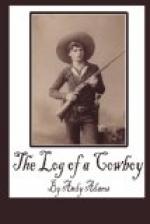And as all of us younger boys learned afterward, there was plenty of good, solid, horse-sense in Flood’s advice; for before the trip ended there were men in our outfit who were as good as afoot, while others had their original mounts, every one fit for the saddle. Flood had insisted on a good mount of horses, and Lovell was cowman enough to know that what the mule is to the army the cow-horse is to the herd.
The first and second day out there was no incident worth mentioning. We traveled slowly, hardly making an average day’s drive. The third morning Flood left us, to look out a crossing on the Arroyo Colorado. On coming down to receive the herd, we had crossed this sluggish bayou about thirty-six miles north of Brownsville. It was a deceptive-looking stream, being over fifty feet deep and between bluff banks. We ferried our wagon and saddle horses over, swimming the loose ones. But the herd was keeping near the coast line for the sake of open country, and it was a question if there was a ford for the wagon as near the coast as our course was carrying us. The murmurings of the Gulf had often reached our ears the day before, and herds had been known, in former years, to cross from the mainland over to Padre Island, the intervening Laguna Madre being fordable.
We were nooning when Flood returned with the news that it would be impossible to cross our wagon at any point on the bayou, and that we would have to ford around the mouth of the stream. Where the fresh and salt water met in the laguna, there had formed a delta, or shallow bar; and by following its contour we would not have over twelve to fourteen inches of water, though the half circle was nearly two miles in length. As we would barely have time to cross that day, the herd was at once started, veering for the mouth of the Arroyo Colorado. On reaching it, about the middle of the afternoon, the foreman led the way, having crossed in the morning and learned the ford. The wagon followed, the saddle horses came next, while the herd brought up the rear. It proved good footing on the sandbar, but the water in the laguna was too salty for the cattle, though the loose horses lay down and wallowed in it. We were about an hour in crossing, and on reaching the mainland met a vaquero, who directed us to a large fresh-water lake a few miles inland, where we camped for the night.
It proved an ideal camp, with wood, water, and grass in abundance, and very little range stock to annoy us. We had watered the herd just before noon, and before throwing them upon the bed ground for the night, watered them a second time. We had a splendid camp-fire that night, of dry live oak logs, and after supper was over and the first guard had taken the herd, smoking and story telling were the order of the evening. The camp-fire is to all outdoor life what the evening fireside is to domestic life. After the labors of the day are over, the men gather around the fire, and the social hour of the day is spent in yarning. The stories told may run from the sublime to the ridiculous, from a true incident to a base fabrication, or from a touching bit of pathos to the most vulgar vulgarity.




